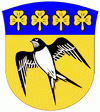Gladsaxe Municipality (Gladsaxe Municipality)
 |
The site of its municipal council is the town of Buddinge. Other towns in the municipality are Gladsaxe, Bagsværd, and Mørkhøj (Søborg is often mentioned wrongly, but it is just a part of Buddinge)—but town limits are not distinguishable because the towns have grown together in an urban sprawl. Mørkhøj, Værebro in Bagsværd and Høje-Gladsaxe are larger housing projects and home to many immigrants and being typical for many concrete highrise suburbs in Copenhagen. Picture of Gladsaxe Heights:
At Gladsaxe, there is a 206.5 m guyed TV mast, which was built in 1955. It was the first TV transmission site in Denmark.
Since 2014, Gladsaxe been home to Copenhagen gem and mineral show, the largest gem and mineral show in Scandinavia. The show is an annual two-day event that attracts exhibitors from all around the world and an audience of thousands from Denmark and Sweden.
Gladsaxe municipality was not merged with other municipalities by 1 January 2007 as the result of nationwide Kommunalreformen ("The Municipal Reform" of 2007).
Gladsaxe municipality is home to many company headquarters, including those of Novo Nordisk, Novozymes and Scandinavian Tobacco Group and MT Højgaard.
Map - Gladsaxe Municipality (Gladsaxe Municipality)
Map
Country - Denmark
 |
 |
| Flag of Denmark | |
As of 2013, the Kingdom of Denmark, including the Faroe Islands and Greenland, has a total of 1,419 islands above 100 m2; 443 of which have been named and of which 78 are inhabited. Spanning a total area of 42943 km2, metropolitan Denmark consists of the northern part of the Jutland peninsula and an archipelago of 406 islands. Of these, the most populated island is Zealand, on which the capital Copenhagen is situated, followed by Funen, the North Jutlandic Island, and Amager. Denmark's geography is characterised by flat, arable land, sandy coasts, low elevation, and a temperate climate. As of 2022, it had a population of 5.928 million (1 October 2022), of which 800,000 live in the capital and largest city, Copenhagen. Denmark exercises hegemonic influence in the Danish Realm, devolving powers to handle internal affairs. Home rule was established in the Faroe Islands in 1948 and in Greenland in 1979; the latter obtained further autonomy in 2009.
Currency / Language
| ISO | Currency | Symbol | Significant figures |
|---|---|---|---|
| DKK | Danish krone | kr | 2 |
| ISO | Language |
|---|---|
| DA | Danish language |
| EN | English language |
| FO | Faroese language |
| DE | German language |















